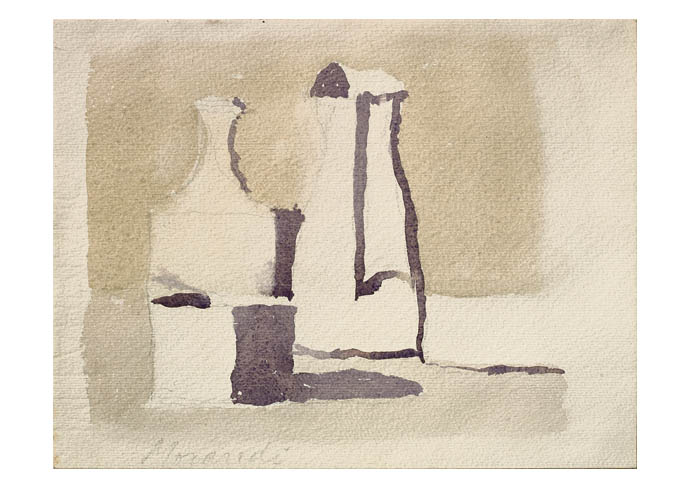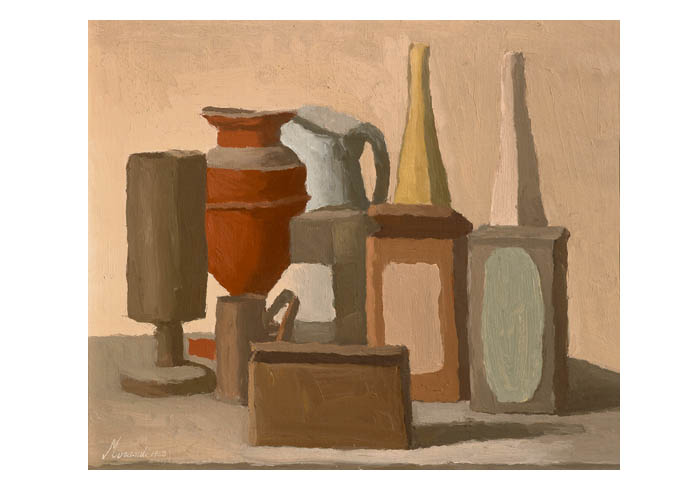Minimal Morandi
The Estorick is marking its 25th birthday with a new show, as John Evans sees
Thursday, 12th January 2023 — By John Evans

Still Life, 1960, Natura morta, watercolour on paper, 16 x 20.5cm
THE first pieces Luigi Magnani acquired by Giorgio Morandi were gifts from the artist, three etchings, not long after they met in 1940.
Two of these, Zinnias in a Vase, 1932, and Flowers in a Small White Vase, 1928, can be seen at the new exhibition at the Estorick Collection of Modern Italian Art in Canonbury.
It was the beginning of a friendship and collaboration that led to the entrepreneur Magnani (1906-1984) buying works by Morandi (1890-1964) and building the fine collection of 50 paintings, etchings and drawings, spanning his entire career, that is on show here.
And its strength is in particular the range of output. For example, just along from the flowers, which have fairly crudely- worked backgrounds, are far more accomplished etchings with finer details, including a row of poplars, a haystack, and a view of buildings through intricate wire fencing with geraniums in front.
The many still lifes which can be seen as core to Morandi’s efforts also vary enormously. Hanging alongside the haystack and poplars can be seen, for example, still lifes with bottles, bowls, a bread basket, cloth and, notably, a coffee pot. There’s fruit and more flowers, but perhaps the best works are later watercolours, a couple of landscapes from the 1950s and still lifes, three of which hang together, from 1959, 1960 and from the year before Morandi’s death.

Still Life, 1942, Natura Morta, oil on canvas, 36 x 42cm
These demonstrate the subtlety which the artist used paint and, as such, better relate to the other room of his works where a number of his delicate oils are displayed.
Again there are contrasts. From 1918, for instance, we can see Metaphysical Still Life, showing the influence of, and homage to, both Giorgio de Chirico and Carlo Carrà and an attempt to offer the viewer the sense of stepping out of reality.
More typical of Morandi however are his still life oils, of muted tones and a distinctive minimalist and light touch, which have seen him described as possessing a “poetic style”.
Here, too, there are flowers, but also a distinctive and unusual bowl of fruit from 1927, with the paint more heavily applied and outlines blurred. Some time later a commentator would write that: “Morandi now paints things as if he sees them reflected in water.”
Still Life with Musical Instruments, from 1941, the only Morandi commission painting is also on show.

Giorgio Morandi, Self-Portrait, 1925, Autoritratto, oil on canvas, 61 x 47.5cm
Not long after Morandi’s death, the American artist Sidney Tillim recalled that the last figure painting mentioned in a monograph of his life’s work had been from 1924 and he wrote: “the still lifes evoke Morandi’s past as a ‘metaphysical’ painter, suggesting a content beyond that represented, a content denied once Morandi banished the figure.”
Which makes the inclusion of a self-portrait in the Magnani collection so notable, one of seven he is known to have painted. One of the first, from around 1917, Morandi destroyed and the last he produced in 1930 (Tillim’s information was not quite complete). Magnani bought the self-portrait here, of the artist aged 35, from another collector and considered it to be the best of the lot.
The Estorick’s own collection of works by Morandi is also on display at the museum, which marks its 25th anniversary this month.
• Giorgio Morandi: Masterpieces from the Magnani-Rocca Foundation is at the Estorick, Canonbury Square, N1 2AN, until April 30.
www.estorickcollection.com/the-collection/giorgio-morandi